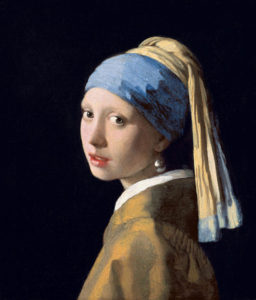
The painting is often called the ‘Mona Lisa of the North’ due to the mystery around the girl’s identity.
October the 31st or November the 1st is celebrated as Dutch painter Johannes Vermeer’s birthday (it’s actually his baptism, not his birthday). I have been living in the Netherlands for 2 years now, where his work is considered a national treasure. I do have¬†a preference for contemporary art, but Dutch Golden Age painters like¬†Vermeer have always represented an exception. While he is often celebrated for his astounding technique, it was the subject of his paintings which first dragged me to his work.
Vermeer is known for his portrayal of austere domesticity and also for his portraits of regular women. The most famous ones are the Milkmaid as well as the Girl with a Pearl Earring which is known for the depiction of the youthful beauty of its model. Yet, the representation of beauty as we know it was certainly not Vermeer’s main goal. Most of the women featured in his paintings would not exactly be considered as conventionally beautiful. This made Vermeer’s paintings a recurrent topic in modern feminist theory.
Despite its notoriety, it is this painting I decided to talk about for my first contribution to the Girl Museum blog. Sometimes the obvious is the right answer and I believe deserves even more attention!
What is striking about this painting, apart from its artistry, is the direct connection it establishes with its viewer. The girl is gazing back at us with her mouth slightly opened as if she was going to address us. This makes the connection almost physical. Despite that shared intimacy, her identity remains a mystery. The girl was said to be one of Vermeer’s conquests, a fellow artist, or, in the preferred version, his oldest daughter.
In my opinion, this mystery makes the connection even stronger. The painting becomes a mirror where the viewer can project its own fantasies and individuality. Indeed, the perception of a painting changes depending on the identity of its viewer. Gender constitutes one of the most important determinant in interpreting our surroundings. After reading many critics written by men, a majority described the girl as seductive. But what compels me to her would be her humble confidence. Self-assurance is a trait I always lacked myself and admire in others.
This gives a whole new dimension to the painting and transforms the passive model into an active and crucial performer. The addition of a black frame, a tradition in 17th century Dutch painting, increases the effect. It allows to eliminate the influence of external elements that could disturb the substitution. While beauty is often used as a commodity in today’s visual culture, her physical appearance seems secondary. Her real beauty seems to reside in her assertive attitude which is reflected onto us. This give the opportunity to the viewer to become an integral part of the painting and to empower it.
-Claire Rochet
Junior Girl
Girl Museum Inc.
